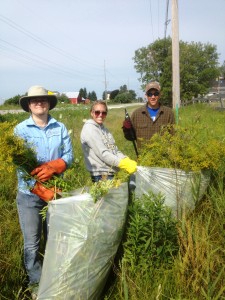Written by Jennifer Powell, Land Management Coordinator for Woodland Dunes Nature Center and Coordinator for the Lakeshore Invasive Species Management Area (LISMA).
 Many yellow flowers are popping up along roadside ditches this time of year. It seems like it is a good year for wild parsnip, much more can be seen this year than in past years. Unfortunately this non-native, invasive plant can pack quite the punch if you aren’t careful around it. Both native and non-native plants in the carrot and parsnip family have the potential to cause harm to people. These plants contain furanocoumarins, a toxic compound that reacts with ultraviolet radiation. Basically, skin contact with sap from these plants, in the presence of uv light, even on a cloudy day, causes rashes, blisters, and other injuries. This condition is called phytophotodermatiits. In some cases, the skin is discolored and the discoloration can last several years. Some plants to look out for include native Cow Parsnip (Heracleum Sphondylium) and Angelica (Angelica atropurpurea), and non-native Giant Hogweed (Heracleum mantegazzianum), Poison Hemlock (Conium maculatum), Wild Parsnip (Pastinaca sativa), Queen Anne’s Lace (Daucus carota), Japanese Hedgeparsley (Torissis japonica), and Wild Cervil (Anthriscus sylvestris).
Many yellow flowers are popping up along roadside ditches this time of year. It seems like it is a good year for wild parsnip, much more can be seen this year than in past years. Unfortunately this non-native, invasive plant can pack quite the punch if you aren’t careful around it. Both native and non-native plants in the carrot and parsnip family have the potential to cause harm to people. These plants contain furanocoumarins, a toxic compound that reacts with ultraviolet radiation. Basically, skin contact with sap from these plants, in the presence of uv light, even on a cloudy day, causes rashes, blisters, and other injuries. This condition is called phytophotodermatiits. In some cases, the skin is discolored and the discoloration can last several years. Some plants to look out for include native Cow Parsnip (Heracleum Sphondylium) and Angelica (Angelica atropurpurea), and non-native Giant Hogweed (Heracleum mantegazzianum), Poison Hemlock (Conium maculatum), Wild Parsnip (Pastinaca sativa), Queen Anne’s Lace (Daucus carota), Japanese Hedgeparsley (Torissis japonica), and Wild Cervil (Anthriscus sylvestris).
All of these plants have flowers in umbels, which resemble the spokes of an umbrella, all coming from a central point. These umbels look like an upside down umbrella with a flat or rounded top of flowers, depending on the species. Flowers are white or yellow, depending on the species. They vary in height from 2 feet to 20 feet. Their leaves vary in appearance from species to species. They are found on roadsides, open woods, pastures, prairies, and fields.
Wild parsnip is a monocarpic perennial, and produces flowers and seeds under favorable conditions after spending one or more years as a rosette. It produces a flat topped yellow flower cluster. Seeds can last 4 years in the soil (seed bank).
The best way to prevent the spread of wild parsnip is to cut it off before its flowers turn to seeds, carefully place the cut part in a black plastic bag for landfilling, and apply a small amount of herbicide directly onto the remaining cut stem. Always make sure to wear proper shoes, long pants, long sleeves, and gloves and avoid getting any sap on your skin.
We’ve been working to prevent wild parship from entering the Woodland Dunes preserve, but each year there are more plants along roadways in our area. This year four of our staff and interns have worked several different days, removing hundreds of plants. We just hope we can prevent this aggressive plant from taking over our prairie plantings and meadows.
Please keep an eye out for these invasive plants and report any potential non-native plants to Invasive.Species@wi.gov and/or jenniferp@woodlanddunes.org.
